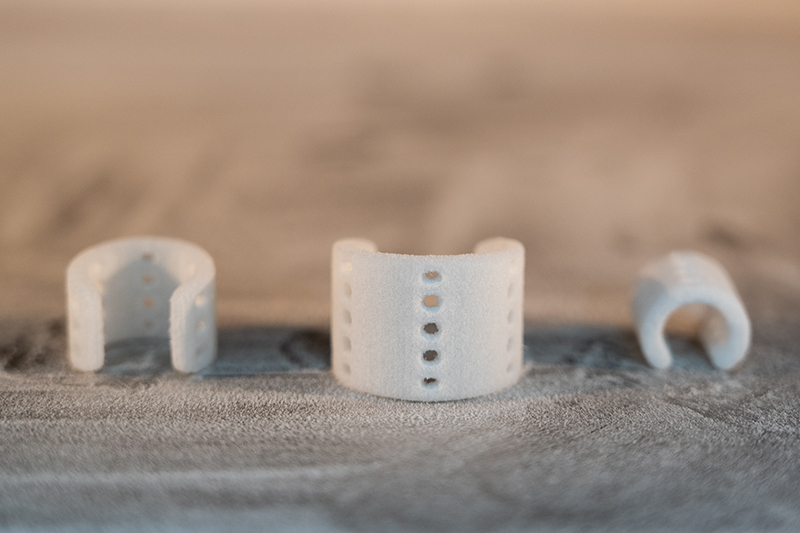There are young children today who are celebrating birthdays and holidays with their families because of the work going on in the lab of Georgia Tech researcher Scott Hollister. His Tissue Engineering and Mechanics Lab (in collaboration in with the Global Center for Medical Innovation) is helping to lead a medical device revolution with the development of 3D-printed, implantable patient-specific devices.
These tracheal and bronchial splints have been used to treat children born with rare conditions, such as tracheobronchomalacia (airway collapse) or tracheal agenesis (a completely absent airway). Collaborating with clinicians who receive emergency clearance from the U.S. Food and Drug Administration (FDA) to use these devices, Hollister’s team is creating life-saving options for little patients who typically don’t have any.
Breakthroughs in 3D printing technology have enabled cutting edge academic research enterprises, like Hollister’s lab as well as traditional medical device companies and others to develop highly personalized devices.
All of which raises an important question: How do you guarantee safety and quality control, especially for patient-specific devices produced in small custom batches? The Hollister lab has an answer for that, too, and it was published in the October edition of the journal Biomaterials.
“We see this work as becoming a template for groups that want to create devices for individual patients – ensuring safety and quality for devices that are not mass produced or tested on a large scale,” said Hollister, professor in the Wallace H. Coulter Department of Biomedical Engineering at Georgia Tech and Emory University.
An example of the Airway Support Devices created in Scott Hollister's lab. A device like this supports the esophagus of a young patient named Ramiah Martin, who was born without a trachea. The device has helped surgeons repurpose her esophagus as a trachea. It's made of biodegradable material that is naturally and safely absorbed in the body. (Photo: Allison Carter)
More than a how-to guide, the Hollister team has created a how-to-do-it-properly script for developing medical devices through 3D printing, which is known as additive manufacturing – the process uses computer-assisted design and 3D object scanners, which direct hardware to deposit material, layer upon layer, to rapidly create a prototype or product.
It’s still an emerging technology in the medical device world, so the rules and regulations are evolving with the use of the technology. In 2017, the FDA released its guidance of the device manufacturing process.
“There is a lot of interest in additive manufacturing, and in regulating how devices manufactured through 3D printing could have the same kind of quality verification process as traditional medical devices,” said Harsha Ramaraju, lead architect of the framework and lead author of the Biomaterials paper. “So, we’ve developed a kind of reference manual, a generalized framework for creating custom devices.”
Since the FDA guidance was released in 2017, this is the first publication to describe the implementation of Good Manufacturing Practice (GMP) methodology for the 3D printing of custom patient specific devices. This framework was used to create devices for a 2018 patient case at Children’s Healthcare of Atlanta, and the paper describes how devices were designed, manufactured, verified, and validated.
The Hollister lab focuses its attention on a process known as laser sintering – laser is used as the heat source on powdered material, binding it together to create a solid structure.
“The unique aspect of this work is that it can be adapted for a lot of other types of additive manufacturing,” Ramaraju said.
The steps Hollister’s team followed in developing its devices – acquiring patient data, design verification, materials verification, parts manufacturing, device evaluation – are the same general steps any other team would need to take in high-quality 3D printed devices.
“Adhering to FDA guidance and implementing a GMP process can only improve the overall quality of a device,” Ramaraju said. “And going forward, it creates avenues for broader use following more traditional pathways for medical devices in the future.”
CITATION: Harsha Ramaraju, April Landry, Subhadra Sashidharan, Abhishek Shetty, Sarah Crotts, Kevin Maher, Steven Goudy, Scott Hollister. “Clinical grade manufacture of 3D printed patient specific biodegradable devices for pediatric airway support.” (Biomaterials, Oct. 2022)
Latest BME News
Jo honored for his impact on science and mentorship
The department rises to the top in biomedical engineering programs for undergraduate education.
Commercialization program in Coulter BME announces project teams who will receive support to get their research to market.
Courses in the Wallace H. Coulter Department of Biomedical Engineering are being reformatted to incorporate AI and machine learning so students are prepared for a data-driven biotech sector.
Influenced by her mother's journey in engineering, Sriya Surapaneni hopes to inspire other young women in the field.
Coulter BME Professor Earns Tenure, Eyes Future of Innovation in Health and Medicine
The grant will fund the development of cutting-edge technology that could detect colorectal cancer through a simple breath test
The surgical support device landed Coulter BME its 4th consecutive win for the College of Engineering competition.









